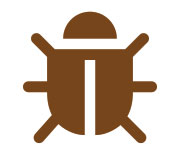 In Northwest Indiana, the house mouse is the most common rodent that causes homeowners discomfort. The house mouse is 5 to 7 inches long, including their tail, and are brown to light grey in color. Under optimal conditions, they can live for a year and produce up to 10 litters containing 5 to 6 young. Mice will forage indoors at any time of the year but are most prevalent during the late fall to winter as they start to seek shelter from the elements and falling temperatures.
In Northwest Indiana, the house mouse is the most common rodent that causes homeowners discomfort. The house mouse is 5 to 7 inches long, including their tail, and are brown to light grey in color. Under optimal conditions, they can live for a year and produce up to 10 litters containing 5 to 6 young. Mice will forage indoors at any time of the year but are most prevalent during the late fall to winter as they start to seek shelter from the elements and falling temperatures.
Mice can be found in any area throughout the home, but they prefer secluded areas such as attics, crawlspaces and basements. They can squeeze through an opening smaller than a dime meaning there are various ways to gain access within the home. The most common points of entry are where electrical lines enter a structure, missing/damaged door sweeps and screens, loose siding or where any improperly sealed item meets the home. Filling these openings with steel wool and caulk are an excellent step in excluding mice from the home, but it is not a guaranteed end result.
Once inside, mice will leave signs of their inhabitants. Seeing droppings, gnawing, nesting sites or seeing the rodent itself are all indicators of an active infestation. One mouse can produce up to 100 droppings per day that are scattered from their nesting to foraging sites. As a way to sharpen their teeth or gain access to water/food sources they will gnaw through a variety of items from wiring to plastic containers. Nesting sites (most easily identifiable in insulation (tunneling)) are where mice find their harborage and are typically in areas away from human interaction.
Rodent infestations can be eliminated through mechanical and chemical methods.
Mechanical methods involve the implementation of snap traps, multi- catch devices, glue boards and/or plug ins that emit sounds to deter mice. This option is very time consuming, requires multiple trips, disposing of carcasses and has the potential for rodents to “wise up” and relocate to another area of the home. Regardless, this method offers many benefits and is a great chemical free option.
Chemical methods (recommended) involve using rodenticide baits. Most baits are produced with a base that attracts mice (within a certain distance) to the poison. Installing bait stations at floor level within the home in key foraging areas in addition to adding bait to known nesting areas (attics, crawlspace) will provide fast and effective results for the elimination of mice.
Think you may have a rodent infestation? CALL TODAY to enroll in our proven baiting program for the elimination of mice! (219) 942-2161








